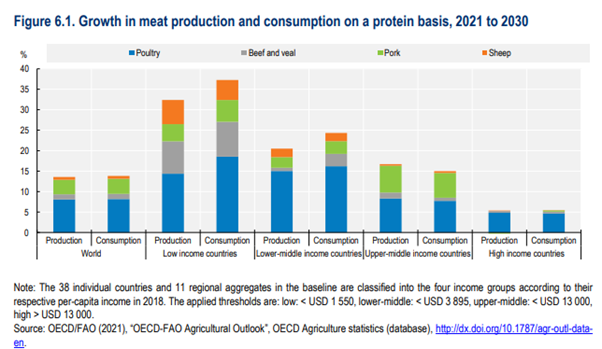Outlook to 2030: Popularity of poultry continues to increase
Tuesday, 20 July 2021
By Bethan Wilkins
The latest OECD-FAO Agricultural Outlook to 2030 has recently been published.
Global meat production is projected to continue growing over the coming decade, but at a slightly slower rate than over the past 10 years. Compared to the 2018-2020 average, meat production is set to increase by 13% by 2030.
The overall increase is led by poultry production, which is set to rise by 17% by 2030, compared to the base period. Poultry benefits from favourable meat-to-feed price ratios and the short production cycle enables rapid genetic improvement. According to OECD-FAO, this will help boost its popularity relative to ruminant meat production in particular. From a consumer perspective, poultry is also perceived as a healthier option and has a lower price-point. Most countries are expected to increase poultry production over the coming decade, though the UK is an exception where production remains relatively stable. Asia shows some of the strongest growth, facilitated by the current ASF-driven pork shortage, which benefits the popularity of poultry in the medium-term.
Pig meat production is forecast to grow by 13% over the outlook period. African Swine Fever is expected to keep production below previous peak levels until 2023, after which a return to steady growth is expected. Specifically, the outlook anticipates that China will return to pre-ASF pork production in 2023. Unlike most regions, pig meat production in the EU and UK is not expected to follow a growth trend, influenced by environmental and public concerns.
Beef is expected to show a much smaller degree of production growth in the coming decade, increasing by just 6%. This reflects weakening demand, as consumers increasingly prefer poultry meat. Within the EU and the UK production is expected to fall, as productivity improvements reduce the size of the dairy herd, while suckler beef faces challenges with profitability.
Sheep meat production is relatively small on a global scale, but a stronger increase of 16% is forecast by 2030. This is mostly due to growth from Asia, particularly China, Pakistan and India. In the EU and UK production is expected to remain stable.

Increases in global meat consumption in the coming decade is largely driven by income and population growth from developing countries. International meat trade will therefore increase in response to growing demand from Asia and the Near East, where demand growth outpaces any increase in production.
The full report, which also covers a range of other agricultural sectors, can be accessed here.
Sign up for regular updates
Subscribe to receive pork market news straight to your inbox. Simply complete our online form.
While AHDB seeks to ensure that the information contained on this webpage is accurate at the time of publication, no warranty is given in respect of the information and data provided. You are responsible for how you use the information. To the maximum extent permitted by law, AHDB accepts no liability for loss, damage or injury howsoever caused or suffered (including that caused by negligence) directly or indirectly in relation to the information or data provided in this publication.
All intellectual property rights in the information and data on this webpage belong to or are licensed by AHDB. You are authorised to use such information for your internal business purposes only and you must not provide this information to any other third parties, including further publication of the information, or for commercial gain in any way whatsoever without the prior written permission of AHDB for each third party disclosure, publication or commercial arrangement. For more information, please see our Terms of Use and Privacy Notice or contact the Director of Corporate Affairs at info@ahdb.org.uk © Agriculture and Horticulture Development Board. All rights reserved.

